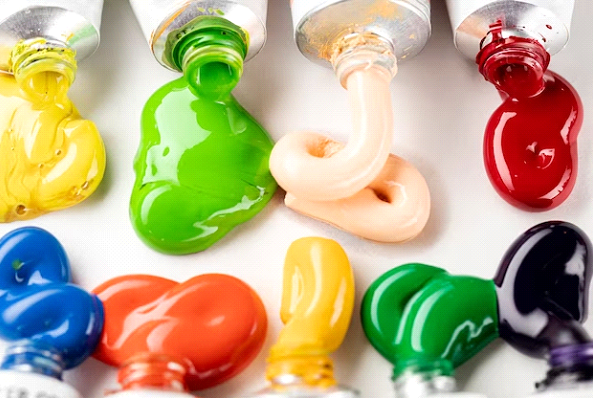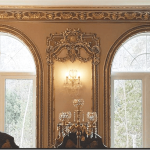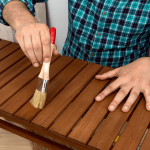Paint is essential to home décor. It adds color to the walls, refreshes a space, or enhances the outside of a home. The right paint may enhance a space’s appearance and sense of style, shield surfaces from damage, and foster a specific mood or ambiance. However, it might be difficult to decide which paint to use since there are so many different types of paint on the market
What is Paint?
Paint is a sticky coating substance that may be applied to various surfaces to protect, improve, and beautify them. It may be manufactured from various materials, including synthetic materials like polymers and resins, as well as natural materials like clay and plant extracts. Paints generally contain pigments, which give them their color. They also have binders, which keep the pigments together and help them stick to surfaces, solvents, which allow the paint spread uniformly, and additives, which enhance the paint’s longevity, resistance to the elements, and drying time.
Different Types of Paints
Water-Based Paints
One of the most often used forms of paint on the market is a water-based paint. They are quick to dry, simple to use, and environmentally safe. Water-based paints come in various varieties, such as emulsion, latex, and acrylic. While latex and acrylic may be used on interior and external surfaces, emulsion paints are ideal for interior walls and ceilings.
Advantages
- Easy clean-up
- Quick drying
- Less odor
Disadvantages
- Less durable than oil-based paints
- May require more coats
- Difficult to remove from surfaces
- Can raise the grain of wood
Oil-Based Paints
The durability and excellent adherence of oil-based paints make them ideal for high-traffic surfaces like doors, trim, and cabinets. Oil-based paints come in two varieties: enamel and alkyd. Enamel paint works well for furniture and metal surfaces, whereas alkyd is frequently used on wood and trim.
Advantages
- Durability
- Excellent Adhesion
- Ability to cover imperfections
Disadvantages
- Strong odor
- Longer drying times
- Require solvents for cleanup.
Specialty Paints
Specialty paints are distinctive varieties created for particular reasons, such as making a surface suitable for use as a blackboard or deterring graffiti. Some examples of specialty paints are epoxy, chalk, magnetic, thermal, and anti-graffiti paints.
Advantages
- Unique properties, such as heat resistance or magnetic properties.
Disadvantages
- Expensive and
- Require specific application techniques
Natural Paints
Natural paints are a healthy and environmentally beneficial alternative to conventional paint. They are produced using organic materials, including milk, clay, and vegetable oil. For anyone with allergies and chemical sensitivity, natural paints are ideal.
Advantages
- Low odor
- Eco-friendliness
- Non-toxic properties
Disadvantages
- More expensive
- Require more coats for complete coverage
Types of Paint Finishes
Flat or matte
Paint is at the bottom end of the glossy continuum and has no luster. It provides a smooth, non-reflective covering that helps hide surface flaws like nail holes.
Eggshell
One of the most often used finishes for interior wall paint because it offers a smooth surface and a low gloss. It works well in common areas like corridors, dining rooms, and living rooms.
Satin
It is regarded as the most adaptable and ideal paint for indoor walls because of its smooth sheen finish and good durability. High-activity areas like playrooms and family rooms, as well as areas with a lot of wetness, such as kitchens and bathrooms, frequently have it.
Semi-Gloss
As its name implies, it has a bright look and gives more excellent reflection than a satin finish. It is an excellent choice for bathrooms, kitchens, and laundry rooms because of its exceptional moisture resistance.
High Gloss
It is probably the most expensive since an increase in sheen translates into an increase in cost. This finish’s brilliant luster is too much, but doors, cabinets, and trim benefit from its exceptional durability.
Tips for Choosing the Right Paint
Consider the surface to be painted
The sort of paint you use should depend on the surface you are painting. For instance, specific paint, such as mold-resistant or moisture-resistant, may be necessary for surfaces exposed to moisture, such as those in bathrooms and kitchens.
Choose the paint finish
The paint finish describes the paint’s shine or glossiness. For walls, matte and eggshell treatments work better; glossy finishes work best for trim and doors. Think about the finish that best achieves the desired look.
Check for VOCs
Seek for paints designated as low or zero VOC when testing for VOCs (volatile organic compounds). You and the environment are both safer with these paints.
Color
Choose a hue that fits the room’s current furnishings and lighting. Moreover, it’s a good idea to try the paint color on a tiny portion of the wall to see how it appears in the illumination of the space.
Brand
Go for a paint company with a solid product quality and client satisfaction track record. Better coverage, longevity, and finish should be expected from high-quality paint than from lesser-quality brands.
Amount of Paint Needed
Compute the square footage of the area that has to be painted to estimate the required amount of paint. This will assist you in determining the appropriate amount of paint for your project without underestimating or overestimating it.

Contact a Paint Specialist at Work!
Don’t hesitate to experiment with new techniques and colors while creating a distinctive design that conveys your unique taste and personality. With time and work, you may alter the interior colors of your house and create the space of ambiance that you love. Feel free to visit our website https://paintmaster.ca/ to learn more about our unique services!
| 2023 HomeStars Award Winners | Official Drywall Contractors For The 2023 Princess Margaret Dream Muskoka Cottage Lottery | Painting Specialists At Work Since 1966 |



